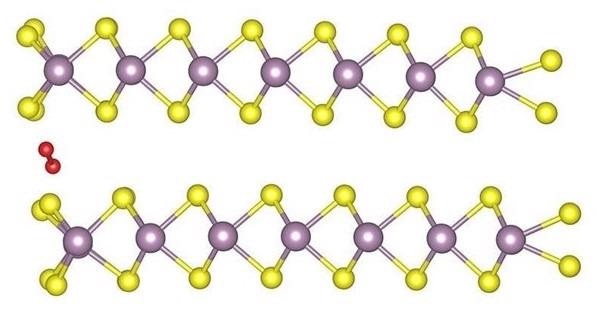Nov 27 2020
Future devices essential for the Internet of Things could be powered by new light-energized material that is more dynamic and considerably brighter compared to present-day photoluminescent material.
 Oxygen molecule (in red) near the gap between two monolayers of metal sulfide called MoS2. Image Credit: Queensland University of Technology.
Oxygen molecule (in red) near the gap between two monolayers of metal sulfide called MoS2. Image Credit: Queensland University of Technology.
According to Professor Ken Ostrikov from the School of Chemistry and Physics and Centre for Materials Science at the Queensland University of Technology (QUT), the new material could be utilized to design the latest transistor devices for electronics and photodetectors for applications ranging from environmental sensing to fiber optic communication systems.
Transistors are tiny electric switches that make up computer chips that run lighting devices such as LEDs, and photodetectors, which detect light of different colors and intensities. These are all elements of sensing and communications devices in the Internet of Things and are the next generation of smart devices.
Ken Ostrikov, Professor, School of Chemistry and Physics, Centre for Materials Science, University of Queensland
Ostrikov added, “The new material we have developed will enable smart devices to process information more quickly, and better talk to each other, make decisions, and take action. Everything from space travel to healthcare, smart cities to our homes will potentially benefit from this material.”
Plasma, or ionized gas, was used to separate layers of atomically thin semiconductors with oxygen atoms to develop the new semi-conducting material.
It is normally very difficult to fit oxygen molecules between the layers so we used plasma. The plasma generated electric fields to charge the oxygen molecules and then drive them to squeeze between the two layers, lifting the top layer away from the bottom one.
Ken Ostrikov, Professor, School of Chemistry and Physics, Centre for Materials Science, University of Queensland
Ostrikov continued, “When separated, the two atomic layers become electrically insulated from each other and the electrons can flow along each 2D layer without losing electrons to the neighboring layer.”
This process resulted in new properties like strong photoluminescence and photocurrent which can be used in devices to give greater controllability and achievable currents, light doses and response speeds that are currently difficult to achieve. This new material could make Internet of Things and other devices more effective and rapid, and cheaper to produce.
Ken Ostrikov, Professor, School of Chemistry and Physics, Centre for Materials Science, University of Queensland
The article titled “2D atomic crystal molecular superlattices by soft plasma intercalation” was published in the Nature Communications journal.
The joint project was co-led by QUT visiting researcher Professor Shaoqing Xiao from Jiangnan University and Professor Kostya (Ken) Ostrikov from the QUT School of Chemistry and Physics and QUT Centre for Materials Science.
The study involved a group of researchers and students from Jiangnan University, co-mentored by professors Xiao and Ostrikov, as well as Professor Aijun Du from the QUT School of Chemistry and Physics and QUT Centre for Materials Science.
QUT Centre for Materials Science
Video Credit: Queensland University of Technology.
Journal Reference:
Zhang, L., et al. (2020) 2D atomic crystal molecular superlattices by soft plasma intercalation. Nature Communications. doi.org/10.1038/s41467-020-19766-x.